Burt A. The Evolution of the British Empire and Commonwealth From the American Revolution
Подождите немного. Документ загружается.

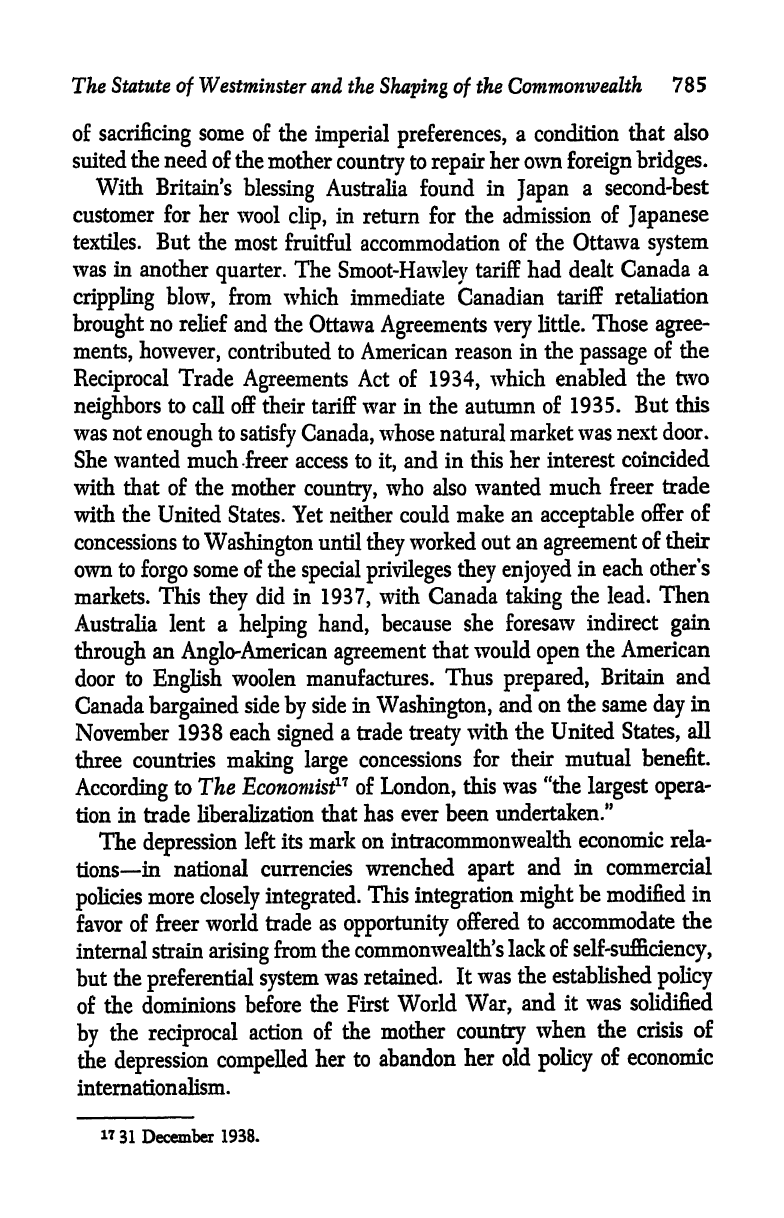
The
Statute
of
Westminster
and
the
Shaping
of
the
Commonwealth
785
of
sacrificing
some
of
the
imperial
preferences,
a condition
that
also
suited
the
need
of
the
mother
country
to
repair
her own
foreign
bridges.
With
Britain's
blessing
Australia found
in
Japan
a second-best
customer
for
her
wool
clip,
in
return
for
the admission
of
Japanese
textiles. But
the
most
fruitful accommodation
of the
Ottawa
system
was
in
another
quarter.
The
Smoot-Hawley
tariff
had
dealt
Canada
a
crippling
blow,
from
which
immediate Canadian
tariff
retaliation
brought
no
relief
and the Ottawa
Agreements
very
little.
Those
agree-
ments,
however,
contributed
to
American
reason
in
the
passage
of the
Reciprocal
Trade
Agreements
Act of
1934,
which enabled
the
two
neighbors
to
call
off their tariff
war
in
the autumn
of
1935.
But
this
was not
enough
to
satisfy
Canada,
whose natural
market was
next
door.
She
wanted
much -freer
access
to
it,
and
in this
her
interest
coincided
with that
of the
mother
country,
who
also
wanted
much
freer
trade
with
the
United
States. Yet
neither
could
make
an
acceptable
offer
of
concessions
to
Washington
until
they
worked out
an
agreement
of
their
own
to
forgo
some
of the
special
privileges
they enjoyed
in each
other's
markets.
This
they
did
in
1937,
with Canada
taking
the
lead.
Then
Australia lent
a
helping
hand,
because
she
foresaw
indirect
gain
through
an
Anglo-American agreement
that
would
open
the
American
door
to
English
woolen
manufactures.
Thus
prepared,
Britain
and
Canada
bargained
side
by
side
in
Washington,
and
on
the same
day
in
November
1938 each
signed
a trade
treaty
with the
United
States,
all
three countries
making
large
concessions
for
their mutual
benefit.
According
to The
Economist
11
of
London,
this
was "the
largest
opera-
tion
in trade
liberalization
that
has
ever been
undertaken."
The
depression
left
its mark
on intracommonwealth
economic
rela-
tionsin
national
currencies
wrenched
apart
and in commercial
policies
more
closely
integrated.
This
integration
might
be modified
in
favor
of
freer
world
trade
as
opportunity
offered
to accommodate
the
internal
strain
arising
from the commonwealth's
lack of
self-sufficiency,
but
the
preferential
system
was retained.
It
was
the established
policy
of
the dominions
before
the
First
World
War,
and it
was
solidified
by
the
reciprocal
action
of
the
mother
country
when
the crisis
of
the
depression
compelled
her
to
abandon
her
old
policy
of
economic
internationalism.
17
31
December
1938.

CHAPTER
XXXVIII
India s
Advance Toward
Dominion
Status
BEFORE
EXAMINING
the
constitutional
progress
of
India
during
the
period
between
the
two
World
Wars,
it
will be well to
look more
closely
at
the
Indian
National
Congress
because it
largely
dominated
the
Indian
political
scene.
Though
its
membership
included
only
a
sprin-
kling
of
Moslems and other
minority
elements,
and
its
affairs
were
managed
almost
exclusively
by
high-caste
Hindus
of
the
professional
class,
it
claimed more
insistently
than ever
to
represent
all
the
people
of India
or,
to use its own
language,
the
whole Indian
nation.
The
Congress
had
just
found
a
phenomenal
leader
in
Gandhi,
who
gave
it mass
momentum. Never in
world
history
has
any
other
man
exercised in
his lifetime such
a
wide and
powerful
spell upon
the
popular
imagination
as
Gandhi
wielded from the end
of
the
First
World
War.
His
leadership
transformed what had been
a
movement
of the
intelligentsia
into
a
movement
of the
people.
In addition
to its
regular
members,
it
could
now
count on
the
support
of
"millions of
unregis-
tered
Congressmen,"
to
quote
Gandhi's own
words.
During
the inter-
war
years
its
fluctuating membership may
have
exceeded four
million.
It was
open
to
anyone
over
eighteen
years
of
age,
regardless
of
race,
religion,
caste,
or
class,
who
professed
a
desire for
national
independ-
ence and
paid
the
paltry
annual
subscription
of
four
annas
(4^d.).
Its
activities,
however,
were
chiefly
financed
by
wealthy
Indians.
There
was
a
local,
a
provincial,
and
a
central
organization,
the
first
being
subject
to control of
the
second,
and the
second under
the com-
mand of
tie
third.
In
each
locality,
such
as a
town,
or
municipal
ward,
or
village,
or little rural
district,
the
primary
members
elected a
primary
Congress
committee
whose main
function
was
propaganda
and
elec-
tioneering.
In
each
of
the
twenty
congressional provinces
they
elected
delegates
to
the annual session of the
Congress,
which
delegates
also
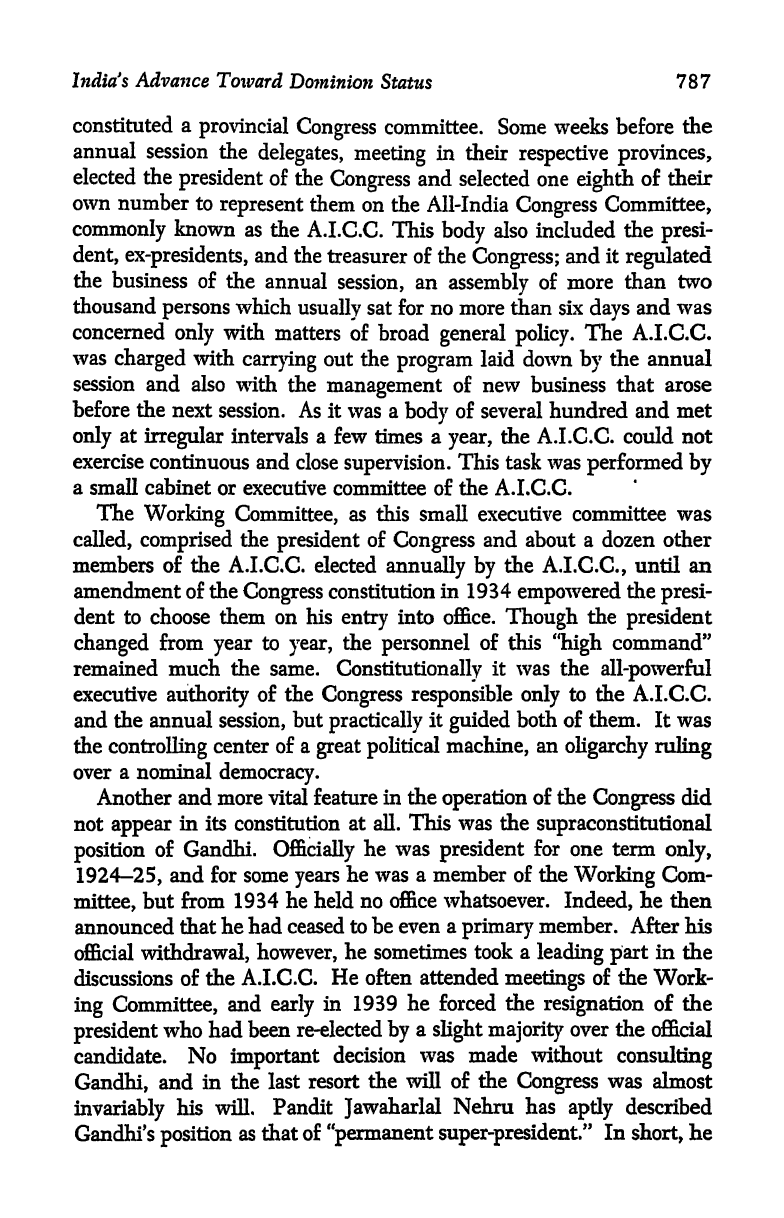
India's Advance
Toward
Dominion
Status
787
constituted
a
provincial
Congress
committee. Some weeks before
the
annual
session
the
delegates,
meeting
in their
respective
provinces,
elected the
president
of the
Congress
and
selected
one
eighth
of
their
own number
to
represent
them
on
the All-India
Congress
Committee,
commonly
known
as
the
A.I.C.C.
This
body
also
included
the
presi-
dent,
ex-presidents,
and the
treasurer
of the
Congress;
and
it
regulated
the
business of
the
annual
session,
an
assembly
of
more
than
two
thousand
persons
which
usually
sat
for no more
than
six
days
and
was
concerned
only
with
matters of
broad
general
policy.
The
A.I.GC.
was
charged
with
carrying
out
the
program
laid
down
by
the annual
session
and also
with
the
management
of
new business
that arose
before the
next
session. As
it
was a
body
of several hundred and
met
only
at
irregular
intervals
a
few times a
year,
the A.I.C.C. could
not
exercise
continuous
and close
supervision.
This
task
was
performed
by
a
small cabinet
or executive
committee of
the
A.I.C.C.
The
Working
Committee,
as this small executive
committee
was
called,
comprised
the
president
of
Congress
and
about a dozen other
members
of
the
A.I.C.C.
elected
annually by
the
A.I.C.C.,
until an
amendment
of
the
Congress
constitution
in
1934
empowered
the
presi-
dent
to choose
them on
his
entry
into office.
Though
the
president
changed
from
year
to
year,
the
personnel
of this
"high
command"
remained much
the
same.
Constitutionally
it was
the
all-powerful
executive
authority
of
the
Congress
responsible
only
to the
A.I.C.C.
and the
annual
session,
but
practically
it
guided
both of
them.
It was
the
controlling
center
of
a
great
political
machine,
an
oligarchy
ruling
over
a
nominal
democracy.
Another and more vital
feature
in the
operation
of the
Congress
did
not
appear
in
its
constitution
at all. This was
the
supraconstitutional
position
of
Gandhi.
Officially
he was
president
for
one
term
only,
1924-25,
and for some
years
he was
a member
of the
Working
Com-
mittee,
but
from
1934 he
held
no
office
whatsoever.
Indeed,
he then
announced
that
he had
ceased
to
be
even
a
primary
member.
After his
official
withdrawal,
however,
he sometimes
took
a
leading
part
in
the
discussions
of
the
A.I.C.C.
He often
attended
meetings
of
the
Work-
ing
Committee,
and
early
in 1939 he forced
the
resignation
of
the
president
who had
been
re-elected
by
a
slight majority
over
the
official
candidate.
No
important
decision
was made without
consulting
Gandhi,
and
in the
last
resort
the
will
of
the
Congress
was
almost
invariably
his
will.
Pandit
Jawaharlal
Nehru has
aptly
described
Gandhi's
position
as
that of
"permanent
super-president/'
In
short,
he
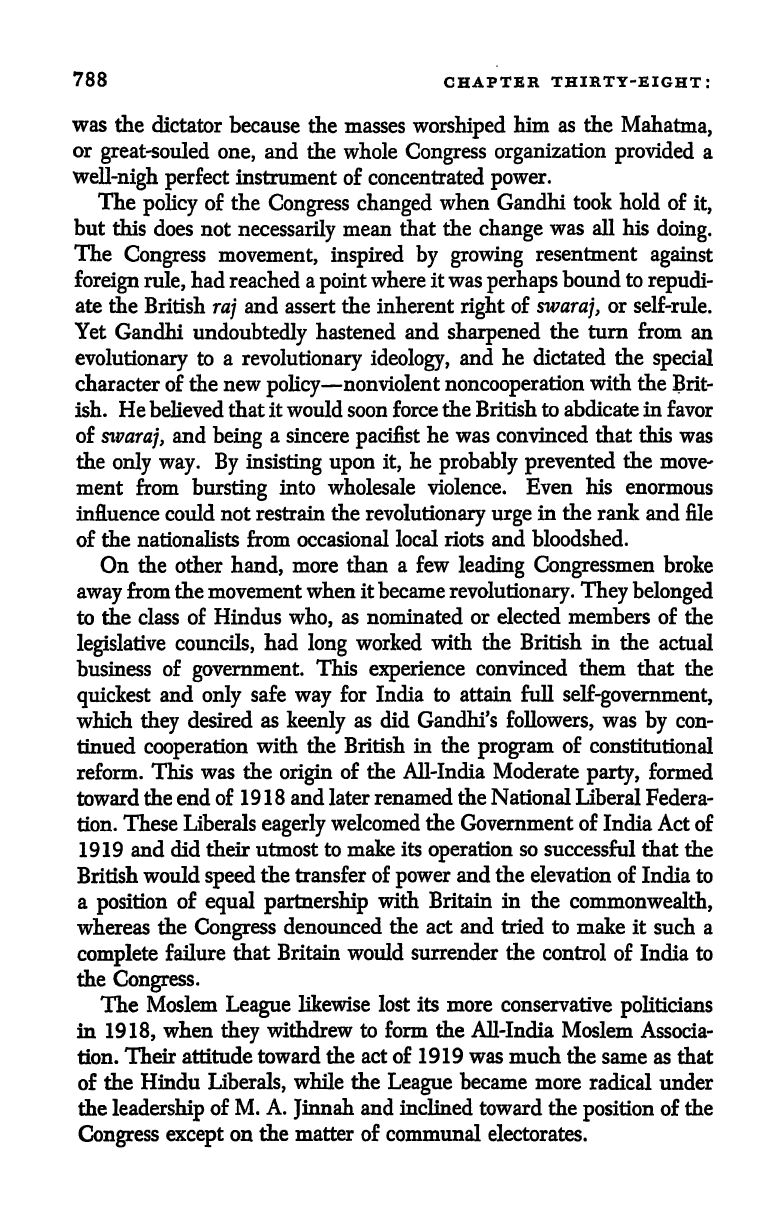
788
CHAPTER THIRTY-EIGHT:
was
the
dictator
because the masses
worshiped
him as the
Mahatma,
or
great-souled
one,
and
the
whole
Congress
organization
provided
a
well-nigh
perfect
instrument of concentrated
power.
The
policy
of the
Congress
changed
when Gandhi
took hold
of
it,
but
this
does
not
necessarily
mean that
the
change
was
all his
doing.
The
Congress
movement,
inspired by growing
resentment
against
foreign
rule,
had reached a
point
where it was
perhaps
bound to
repudi-
ate
the
British
raj
and
assert
the
inherent
right
of
swaraj,
or
self-rule.
Yet
Gandhi
undoubtedly
hastened and
sharpened
the
turn
from
an
evolutionary
to
a
revolutionary
ideology,
and he dictated
the
special
character of
the new
policy
nonviolent
noncooperation
with the
Brit-
ish. Hebelieved
that it
would
soon force the
British
to
abdicate
in
favor
of
sivaraj,
and
being
a
sincere
pacifist
he
was convinced
that
this
was
the
only way. By
insisting
upon
it,
he
probably
prevented
the
move-
ment from
bursting
into wholesale
violence.
Even his
enormous
influence could not
restrain the
revolutionary
urge
in the rank
and file
of the nationalists from
occasional
local riots
and
bloodshed.
On
the other
hand,
more
than
a
few
leading
Congressmen
broke
away
from
the
movement
when it became
revolutionary.
They
belonged
to the
class of Hindus
who,
as nominated
or elected members of
the
legislative
councils,
had
long
worked
with the
British
in
the
actual
business
of
government.
This
experience
convinced them that
the
quickest
and
only
safe
way
for India to
attain full
self-government,
which
they
desired
as
keenly
as did
Gandhi's
followers,
was
by
con-
tinued
cooperation
with the
British
in
the
program
of
constitutional
reform.
This
was the
origin
of the All-India Moderate
party,
formed
toward
the
end of 19
1
8
and
later
renamed the National
Liberal Federa-
tion.
These
Liberals
eagerly
welcomed
the
Government of
India
Act of
1919 and
did
their utmost to
make its
operation
so
successful
that
the
British
would
speed
the transfer of
power
and
the
elevation
of
India to
a
position
of
equal
partnership
with
Britain in
the
commonwealth,
whereas the
Congress
denounced
the act and tried
to make
it such a
complete
failure
that
Britain
would surrender the
control of India to
the
Congress.
The Moslem
League
likewise
lost its
more
conservative
politicians
in
1918,
when
they
withdrew to form the
All-India
Moslem Associa-
tion.
Their attitude
toward
the
act of 1919 was
much
the
same as that
of
the
Hindu
Liberals,
while
the
League
became
more
radical
under
the
leadership
of
M.
A.
Jinnah
and inclined
toward
the
position
of
the
Congress
except
on
the matter
of communal
electorates.
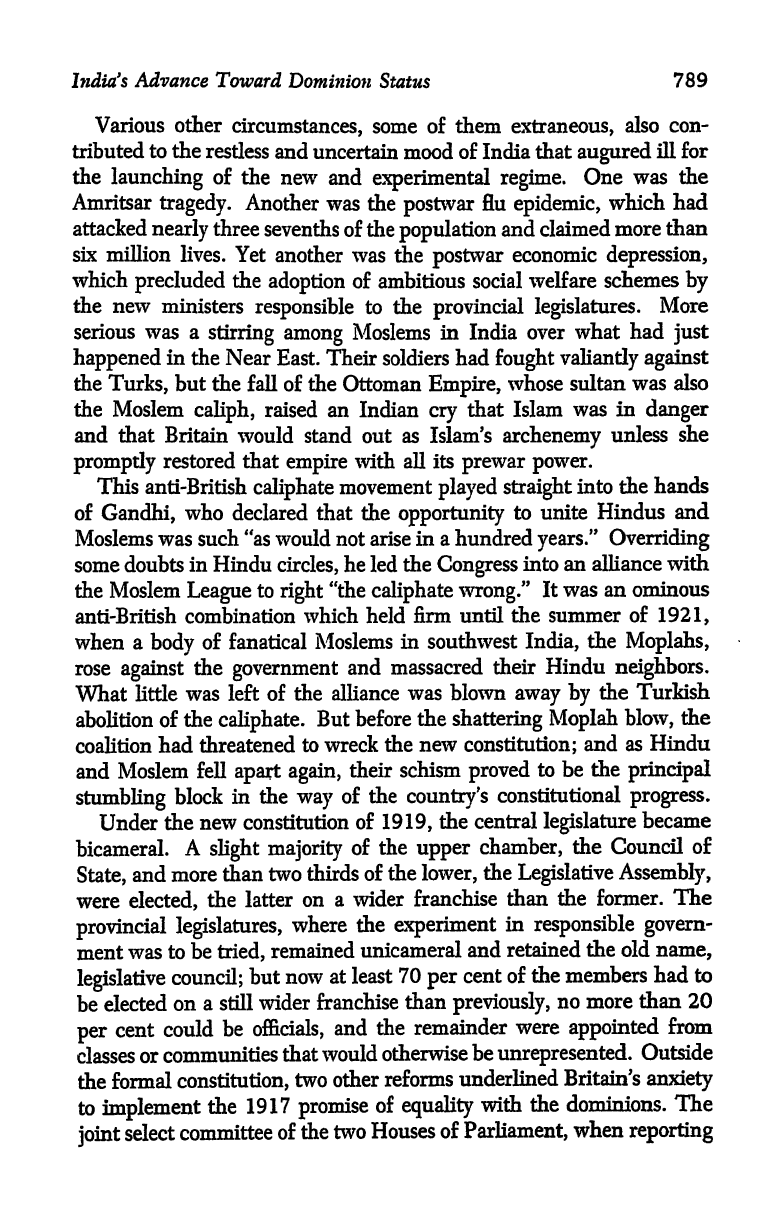
India's
Advance Toward
Dominion Status
789
Various
other
circumstances,
some of
them
extraneous,
also
con-
tributed
to the
restless and
uncertain
mood
of India
that
augured
ill
for
the
launching
of
the new
and
experimental
regime.
One
was
the
Amritsar
tragedy.
Another
was the
postwar
flu
epidemic,
which had
attacked
nearly
three
sevenths
of the
population
and claimed
more
than
six million
lives. Yet
another was the
postwar
economic
depression,
which
precluded
the
adoption
of ambitious social
welfare schemes
by
the
new
ministers
responsible
to the
provincial
legislatures.
More
serious was
a
stirring
among
Moslems
in India
over what
had
just
happened
in
the Near
East. Their
soldiers
had
fought
valiantly
against
the
Turks,
but
the
fall of
the
Ottoman
Empire,
whose
sultan
was also
the
Moslem
caliph,
raised
an
Indian
cry
that
Islam
was in
danger
and that
Britain
would
stand
out as
Islam's
archenemy
unless
she
promptly
restored that
empire
with
all
its
prewar
power.
This
anti-British
caliphate
movement
played straight
into the
hands
of
Gandhi,
who
declared that the
opportunity
to
unite Hindus
and
Moslems was such "as would not arise
in a hundred
years."
Overriding
some doubts
in
Hindu
circles,
he led
the
Congress
into
an alliance
with
the Moslem
League
to
right
"the
caliphate wrong."
It
was an ominous
anti-British combination
which held
firm until
the summer of
1921,
when
a
body
of
fanatical Moslems
in southwest
India,
the
Moplahs,
rose
against
the
government
and massacred
their
Hindu
neighbors.
What
little
was left of
the alliance
was blown
away
by
the
Turkish
abolition of
the
caliphate.
But before
the
shattering
Moplah
blow,
the
coalition
had threatened
to wreck
the
new
constitution;
and as
Hindu
and
Moslem
fell
apart again,
their schism
proved
to be
the
principal
stumbling
block
in the
way
of
the
country's
constitutional
progress.
Under
the
new constitution
of
1919,
the central
legislature
became
bicameral.
A
slight
majority
of
the
upper
chamber,
the Council
of
State,
and more
than
two
thirds of
the
lower,
the
Legislative
Assembly,
were
elected,
the latter
on
a wider
franchise
than
the former.
The
provincial
legislatures,
where the
experiment
in
responsible govern-
ment
was to be
tried,
remained
unicameral and
retained
the
old
name,
legislative
council;
but
now
at least
70
per
cent of
the members had to
be
elected
on
a still
wider
franchise
than
previously,
no
more than 20
per
cent
could
be
officials,
and
the
remainder
were
appointed
from
classes
or
communities
that
would
otherwise
be
unrepresented.
Outside
the
formal
constitution,
two
other
reforms
underlined
Britain's
anxiety
to
implement
the
1917
promise
of
equality
with
the dominions.
The
joint
select
committee
of
the two
Houses
of
Parliament,
when
reporting

790
CHAPTER
THIRTY-EIGHT:
on
the bill
in
1919,
declared
that
India
should
have
the
same
tariff
autonomy
as the
dominions.
This
principle
was
promptly
adopted
in
the
so-called "Fiscal
Convention,"
and
its
application
was
upheld
by
the
British
government
against
the
loud
protests
of
British
manufacturers.
The second reform
was
the
progressive
replacement
of
Britons
by
Indi-
ans in the
upper
grades
of
the
civil
and
military
services
of
the
country.
1
The
Congress
boycotted
the
first
elections
under
the
act
of
1919,
which
were held
in the
autumn
of
1920.
Backed
by
attempts
to
inter-
fere with
the
polling
and
by
charges
that
all
who
accepted
the
act
were
traitors to
the national
cause,
the
boycott
was
part
of Gandhi's
first
noncooperation
campaign,
which
had
begun
earlier
in the
year.
It
collapsed
in
1922,
when
his
preaching
of
civil
disobedience
bore
bloody
fruit
in the
murder
of
a score
of
policemen
in
one
province
and
landed
him
in
jail.
During
his confinement
he
was
released
on
compassion-
ate
grounds
of
health
in 1924
there
was
a hot
dispute
in the
Congress
over
what
it
should
do
in
the
elections
of
1923.
Many Congressmen
now
condemned
the
boycott
of
1920
as
a
major
blunder
because
it
had
left
the door
wide
open
for
the Liberals
to
enter
the
legislatures
and
take office
as
ministers
in most
of
the
provincial
governments.
Other
Congressmen,
however,
insisted
that
it
was
still the
right
tactics. The
dispute
ended
with
a
majority
decision
to
run candidates for the
purpose
not of
working
the constitution
but
of
obstructing
its
operation.
The
sequel
gives
a
rough
indication
of
the
political
weight
of
the
Congress.
The
percentage
of
the
electorate
who cast
their votes in 1923
was
39.9,
an
increase
from
29
in
1920;
and
a considerable
number
of
Swarajists,
as
they
were
now
called,
won
seats
in
every provincial
legislature
except
that of
Madras. In
only
two
of
the
other
provinces
were
they
able
to block
the
legislative
passage
of
supplies
and
force
the
governors
to resume
control
of
"transferred"
subjects,
and there the
deadlock
was broken
two
years
later.
The
elections
of 1926
brought
out
42.6
per
cent
of the
registered
voters
and
were
the
occasion of
large-
scale
rioting
between
Hindus
and
Moslems,
which
destroyed
much
property
and
spilled
more
than a little blood.
Dyarchy
was
working
and
it continued to work until it was
super-
seded
by
another
British-made
constitution
in 1937.
The
Liberals
got
the
system working
while there
was little
internal
opposition,
thanks
to
the
initial
boycott;
and
they
kept
it
going,
thanks to
the
loyal support
1
The lower
grades
of
the
civil
service,
comprising
the vast
majority
of the
personnel,
had
always
been
Indian.

India's
Advance
Toward
Dominion Status
791
of
efficient
British
civil
servants,
who
were now
under
Indian
masters,
and
to
the
Swarajists
in
the
legislatures,
who
were
not
always
intran-
sigent.
Indeed,
it was
observed
that
these
Congressmen
tended
to
assume
the
role
of
a
constitutional
opposition,
and that
they
not
.infrequently
helped
the administration
by
their
keen criticism.
Though dyarchy
had
not
been
introduced
into
the central
govern-
ment,
the
viceroy's
executive
council
now
included
three
Indians
instead
of
only
one,
and
for
the first
time
it was confronted
by
a
large
elected
majority
in the
legislature,
to
which most
of
the ablest
politi-
cians
gravitated.
The result was rather
surprising.
Though
the
legisla-
tive
majority
had no constitutional
control
over
the
executive
and
might
be overridden
by
the
viceroy
when
they
refused
to
pass
any
particular
bill that
he
"certified"
was
essential,
and
though
they
were
a
permanent
opposition pressing
for
the concession
of
responsible government,
a
large
body
of
very
useful
legislation
was
enacted
without
recourse
to
certification,
2
for
they
listened
to
the
government
spokesmen
usually
with
patience
and often
with
assent,
and
their
influence
upon
the
executive
was no less
remarkable.
Yet
the act of
1919 did not
achieve
its
primary
object
of
giving
the
people
of
India
a real
training
in
responsible
government,
and
dyarchy
was
partly
to blame
for
this
failure. When
put
to the
test of
experience,
a
governor,
half
autocrat
and half
constitutional
sovereign,
an executive
split
into
two
compartments
operating
on
opposite
principles,
a
legisla-
ture
controlling
the
policy
of
only
one half
of the
administration
while
free
to
criticize
and even
to
withhold
supply
from
the other
half
all
made
for
political
confusion
rather
than
political
education.
Practical
problems
were forever
arising
that straddled
the division
between
the
"reserved"
and
the
"transferred"
subjects,
and
there
was a chronic
tendency
of
the
politicians
to
magnify
their functions
on
the "reserved"
side
at
the
expense
of
neglecting
their
opportunities
on
the
"trans-
ferred"
side.
The
nature
of Indian
society
was
the fundamental
reason for
this
failure
of
the
act
to
serve
its
main
purpose.
The British
authors of
the
act
sincerely
hoped
but
seriously
doubted
that
responsible government,
which
their
own
very
different
kind
of
society
had
slowly
evolved,
could
be
applied
in India
as
it
had been
in the
colonies.
Indian
politicians,
however,
soon
made
it clear
that
this
was
what
they
wanted,
but
they
did
not
develop
the
party
system
essential
for
its
operation
Responsible
2
It was used
only
ten
times
during
the
life
of the constitution.

792
CHAPTER
THIRTY-EIGHT:
government
cannot work
without
political
parties
to
organize
the
legis-
lative
majority,
whose
leaders
form
an
administration,
and
an
opposi-
tion to
provide
an
alternative
government.
In
India
there was
only
one
well-organized
and
disciplined
party,
that of
the
Swarajists.
They
alone
had a definite
policy
but
this
was
wholly
negative.
The
Liberals
were
not
a
real
political
party.
They
lacked
die
necessary
funds
and
cohesion,
and
they
were
inclined
to
break
into
shifting groups
under
different
names
and leaders.
The
Moslem
League
was
wholly
com-
munal and
comprised
no
more
than
a
minority
of
politically-minded
Moslems. In
only
two
provinces
did
anything
like
a
genuine
political
party
appear:
the
Justice
party,
of anti-Brahmin
Hindus,
in
Madras;
and the National
Unionist
party,
intercommunal,
in the
Punjab.
It
was
perhaps
inevitable
in the
plural
society
of India
that
party
divisions
generally
followed
communal
lines
instead
of
being
based
on
political
principle.
The line that
cut
the
deepest
was between
Hindu and
Moslem.
It
had been
there for
centuries
before
the
British
entered
India,
and
now
the
prospect
of
national
freedom
from
British
control
accentuated
the
antagonism
between
these
two
major
communities
by
precipitating
a
struggle
for
place
and
power against
the
day
of
the
foreign
arbiter's
withdrawal.
Though
the
League
and
the
Congress
agreed
that the
country
should
have an Indian-made
constitution
with
a
parliamentary
form
of
government,
they
parted
company
on
two basic issues. The
League
accepted
the
commonwealth
and
sought
equality
within
it,
while
the
Congress
rejected
it as
derogatory
to
Indian nationhood. The
League
demanded
a federal constitution
with
the
fullest
possible pro-
vincial
autonomy,
so that
Moslems
would
have the maximum
freedom
to rule the
three
provinces
where
they
were
in a
majority;
whereas the
Congress,
claiming
to
speak
for
British India as
a
whole,
insisted
upon
a
unitary
constitution
to consolidate
the
country
and,
incidentally,
to
deliver
its rule
into the
hands of the over-all
Hindu
majority.
Leaders
on
both
sides saw
grave
dangers
ahead
unless
they
could
come
together
and
work
out some
mutually acceptable
constitution.
Haste
seemed
necessary
when,
as a
consequence
of
continual
prodding
by
Liberals
in
the
Legislative
Assembly,
the
British
government
ap-
pointed
the Simon
Commission
in the autumn
of
1927
to review the
working
of
the
constitution
two
years
before
the
time set in
1919.
A
conference
representing
all Indian
parties
met
in
February
1928,
only
to
be
paralyzed
by
internal conflict
between the
Moslem
League
and
the
Mahasabha,
a
newly-formed organization
of
fanatical Hindus.
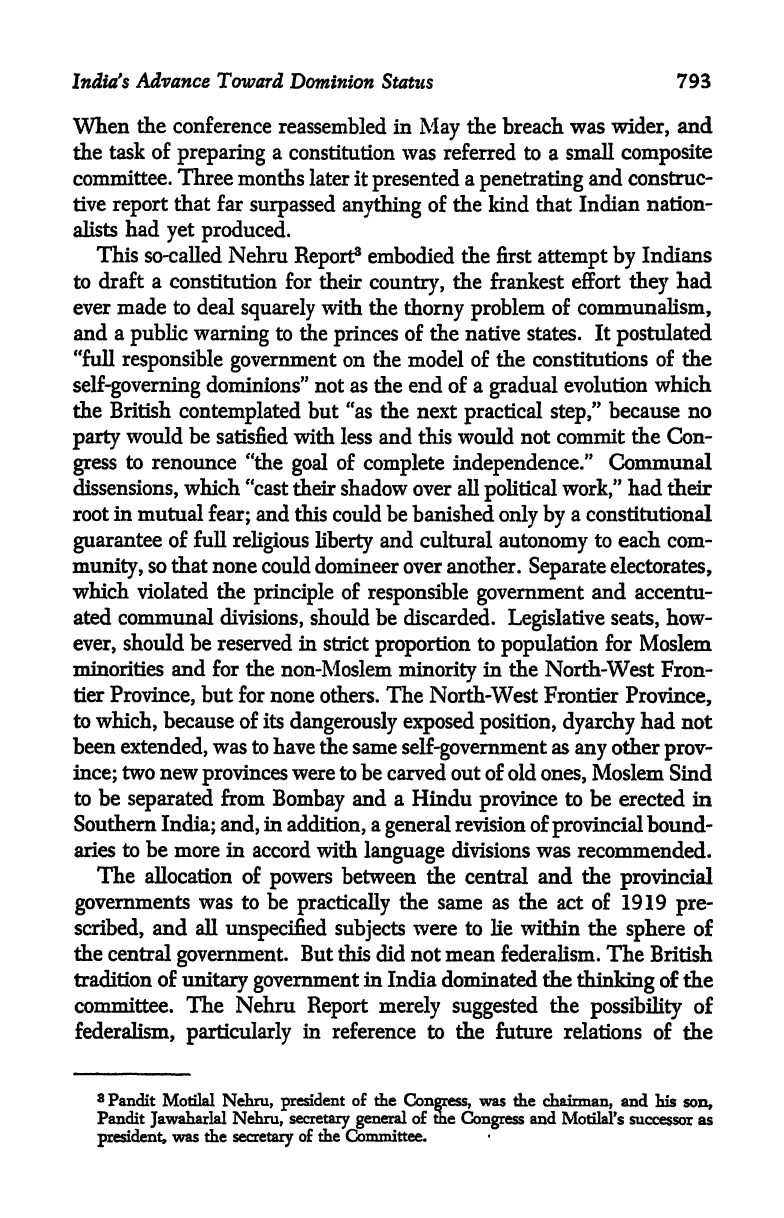
India's
Advance
Toward
Dominion Status
793
When
the
conference
reassembled in
May
the breach
was
wider,
and
the
task of
preparing
a
constitution
was referred
to a
small
composite
committee.
Three
months later
it
presented
a
penetrating
and
construc-
tive
report
that far
surpassed
anything
of
the
kind
that
Indian
nation-
alists
had
yet
produced.
This
so-called Nehru
Report
3
embodied
the first
attempt by
Indians
to
draft
a
constitution
for their
country,
the
frankest
effort
they
had
ever
made to deal
squarely
with the
thorny problem
of
communalism,
and a
public
warning
to
the
princes
of the
native states. It
postulated
"full
responsible
government
on the
model
of
the
constitutions
of the
self-governing
dominions"
not as
the end of
a
gradual
evolution
which
the British
contemplated
but
"as
the next
practical
step,"
because
no
party
would
be
satisfied with
less and this would
not commit
the
Con-
gress
to
renounce
"the
goal
of
complete independence."
Communal
dissensions,
which
"cast
their shadow over
all
political
work,"
had
their
root
in
mutual
fear;
and this
could
be
banished
only by
a constitutional
guarantee
of
full
religious liberty
and cultural
autonomy
to each com-
munity,
so that
none
could domineer
over
another.
Separate
electorates,
which violated the
principle
of
responsible
government
and
accentu-
ated communal
divisions,
should be discarded.
Legislative
seats,
how-
ever,
should be
reserved in
strict
proportion
to
population
for
Moslem
minorities
and
for the
non-Moslem
minority
in the
North-West
Fron-
tier
Province,
but
for
none others. The
North-West Frontier
Province,
to
which,
because
of its
dangerously
exposed
position, dyarchy
had
not
been
extended,
was to
have the same
self-government
as
any
other
prov-
ince;
two new
provinces
were
to be carved out of
old
ones,
Moslem
Sind
to
be
separated
from
Bombay
and a Hindu
province
to
be erected in
Southern
India;
and,
in
addition,
a
general
revision
of
provincial
bound-
aries
to be
more in
accord
with
language
divisions
was
recommended.
The
allocation of
powers
between the central and
the
provincial
governments
was
to be
practically
the
same
as the act of
1919
pre-
scribed,
and
all
unspecified subjects
were
to lie
within
the
sphere
of
the
central
government.
But this
did not mean federalism. The
British
tradition
of
unitary
government
in
India dominated the
thinking
of
the
committee.
The Nehru
Report merely
suggested
the
possibility
of
federalism,
particularly
in
reference to the future
relations
of
the
8
Pandit
Motilal
Nehru,
president
of
the
Congress,
was
the
chairman,
and
his
son,
Pandit
Jawaharlal
Nehru,
secretary general
of
the
Congress
and
Motilal's
successor
as
president,
was
the
secretary
of
the
Committee.
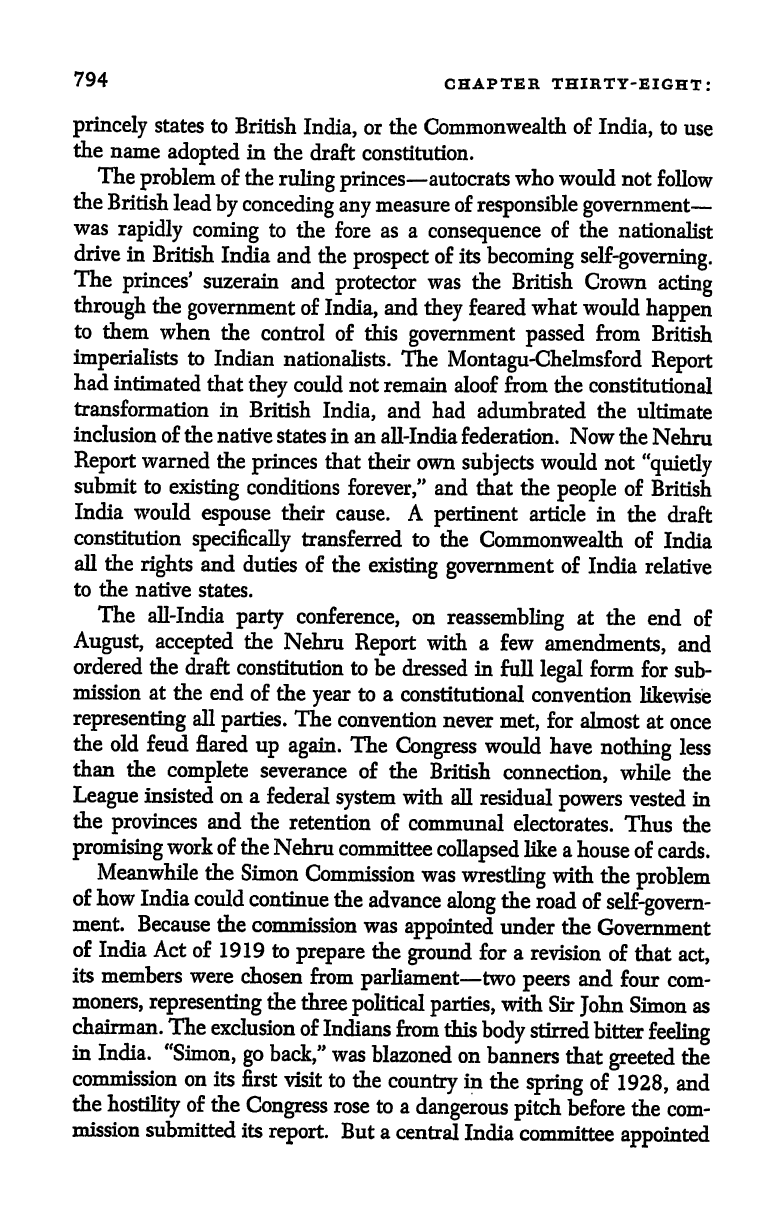
794
CHAPTER
THIRTY-EIGHT:
princely
states
to
British
India,
or the Commonwealth
of
India,
to
use
the
name
adopted
in the
draft constitution.
The
problem
of the
ruling
princes
autocrats
who
would not
follow
the
British
lead
by
conceding
any
measure of
responsible
government
was
rapidly
coming
to the
fore as a
consequence
of
the
nationalist
drive
in
British
India
and the
prospect
of its
becoming
self-governing.
The
princes'
suzerain
and
protector
was
the
British
Crown
acting
through
the
government
of
India,
and
they
feared
what
would
happen
to
them
when
the
control
of
this
government
passed
from
British
imperialists
to
Indian
nationalists. The
Montagu-Chelmsford
Report
had
intimated
that
they
could
not
remain
aloof from
the
constitutional
transformation in
British
India,
and had adumbrated the
ultimate
inclusion of
the
native states
in an
all-India
federation. Now
the
Nehru
Report
warned the
princes
that
their
own
subjects
would not
"quietly
submit
to
existing
conditions
forever,"
and that the
people
of
British
India
would
espouse
their
cause. A
pertinent
article in
the
draft
constitution
specifically
transferred
to
the
Commonwealth
of
India
all the
rights
and
duties of
the
existing government
of
India
relative
to the
native
states.
The
all-India
party
conference,
on
reassembling
at
the
end
of
August,
accepted
the
Nehru
Report
with
a
few
amendments,
and
ordered the
draft
constitution
to
be
dressed in
full
legal
form
for
sub-
mission
at
the
end of the
year
to a
constitutional
convention
likewise
representing
all
parties.
The
convention
never
met,
for
almost at
once
the
old feud
flared
up
again.
The
Congress
would have
nothing
less
than
the
complete
severance of the
British
connection,
while
the
League
insisted on a
federal
system
with
all
residual
powers
vested in
the
provinces
and the
retention
of
communal
electorates.
Thus
the
promising
work
of
the
Nehru
committee
collapsed
like a
house
of
cards.
Meanwhile
the
Simon
Commission
was
wrestling
with
the
problem
of how
India
could
continue
the
advance
along
the
road
of
self-govern-
ment.
Because
the
commission
was
appointed
under
the
Government
of India
Act
of
1919
to
prepare
the
ground
for a
revision
of that
act,
its
members
were
chosen
from
parliament
two
peers
and
four
com-
moners,
representing
the
three
political
parties,
with
Sir
John
Simon as
chairman.
The
exclusion
of
Indians
from
this
body
stirred
bitter
feeling
in India.
"Simon,
go
back,"
was
blazoned on
banners
that
greeted
the
commission
on
its
first
visit
to
the
country
in
the
spring
of
1928,
and
the
hostility
of
the
Congress
rose
to a
dangerous
pitch
before the
com-
mission
submitted
its
report.
But a
central
India
committee
appointed
